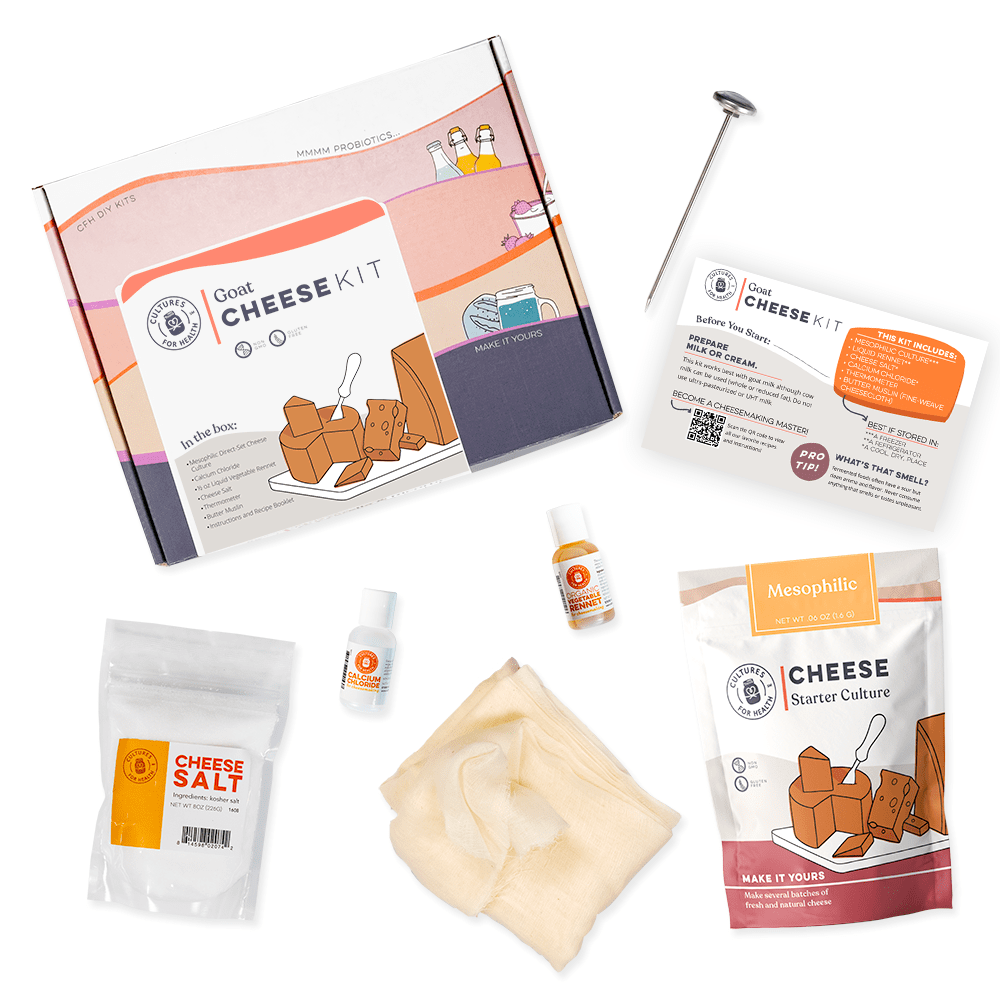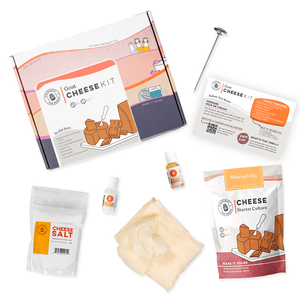
Cow milk is what comes to mind for most people when thinking about what to put on their cereal and for making cheese, yogurt, kefir, ice cream, and the many other types of dairy products. Some may be surprised to learn that goat milk is very prevalent and commonly found on kitchen tables in many cultures around the world. Goat milk is as versatile as cow milk in just about every area. There are several factors that influence one's personal preferencebetweengoatmilkvs cow milk for drinking, cheese-making, culturing, baking, or cooking.
Click to download our Cheesemaking Guide book today. Our goal is to share our knowledge with you so that you can make the best decision for yourself and your family. That's why we've created cookbooks with recipes using goat's milk and cow's milk.
TASTE DIFFERENCE BETWEEN GOAL MILK VS COW MILK
The distinctive flavor of goat cheese has earned its niche in the world of delicacy flavors found in fine delis, restaurants, and gourmet supermarkets. For some, that distinctive taste is the reason for a preference for goat milk products; for others it is a reason to prefer cow milk! In the world of raw and cultured milk, fresh goat and cow milk can have basically the same taste due to their similar compositions, or can be quite different. This can depend on proper processing and handling of the milk as well as the diet of the animal.Many say the taste of goat milk is slightly sweeter than that of cow milk. However, mass-produced goat milk sold in most stores can be have a “goaty” taste due to different methods of processing, packaging, and pasteurization. (See Tips and Troubleshooting for Better-tasting Goat Milk.)
IS GOAT MILK BETTER THAN COW MILK'S APPEARANCE?
Goats convert the carotene in their diet to vitamin A more efficiently than cows do, producing whiter milk, cream, and butter.Those who prefer a classic yellow hue to their butter may use annatto (cheese coloring) to add color back in during processing.
Download our Free Cookbooks and learn about the difference between goat's milk vs cow's milk today!
CONSISTENCY BETWEEN GOAL MILK VS COW MILK
It takes the milk of approximately five to ten goats to equal the production of one cow. However, once the milk has been extracted from the animal, the difference in consistency of cow milk compared to goat milk is minor. The amount of cream in goat milk is not insignificant; however, the fat globules in goat milk are much smaller than those in cow milk resulting in the cream remaining suspended throughout the milk instead of rising to the top. In addition, goat milk does not contain agglutinin, the compound in cow milk that enables the fat globules to cluster and rise to the top. Due to this natural homogenization, a cream separator is generally used if goat cream is desired. One may prefer using raw cow milk when making butter, sour cream, and similar items due to the ease of separating the cream from the milk.
Goat Cheese Making Kit
NUTRITION
Goat milk is an excellent alternative to cow milk. The composition of any type of milk can vary depending on the animal’s breed, diet, environment, and point in the lactation period, but on average, this is how cow milk and goat milk compare:
| COMPOSITIONS (Per 100 grams) | GOAT | COW |
| Protein (g) | 3.1 | 3.2 |
| Fat % (g) | 3.5 | 3.9 |
| Calories/100 ml | 60 | 66 |
| Vitamin A (IU/gram fat) | 39 | 21 |
| Vitamin B1(thiamin (UG/100/ml) | 68 | 45 |
| Riboflavin (ug/100 ml) | 210 | 159 |
| Vitamin C (mg ascorbic acid/100 ml) | 2 | 2 |
| Vitamin D (IU/gram fat) | 0.7 | 0.7 |
| Calcium % | 0.19 | 0.18 |
| Iron % | 0.07 | 0.06 |
| Phosphorus % | 0.27 | 0.23 |
| Cholesterol (mg/100 ml) | 10 | 14 |
| Sugars (lactose) | 4.4 | 4.8 |
| Saturated fatty acids (g) | 2.3 | 2.4 |
| Monounsaturated fatty acids (g) | 0.8 | 1.1 |
| Polyunsaturated fatty acids (g) | 0.1 | 0.1 |
DIGESTION
The smaller fat globules in goat milk result in a smaller and softer curd, enabling digestive enzymes to break it down more rapidly. Goat milk also has higher levels of short- and medium-chain fatty acids, rendering a faster and easier digestion process as well as producing quicker energy.Many people prefer goat milk for these reasons.
LACTOSE TOLERANCE
The sugar in milk is called lactose. Some people have low levels of the enzyme lactase, which is responsible for digesting lactose, and are therefore “lactose intolerant.” The symptoms of lactose intolerance include mild to extreme discomfort, so lactose-intolerant individuals often choose to eliminate anything containing lactose from their diet. Goat milk contains less lactose than cow milk, which may make it a better option for those with mild lactose sensitivities. Individuals concerned about lactose tolerance are advised to consult with their health care practitioners regarding the advisability of consuming any dairy products.
ALLERGY
A milk allergy is a physical reaction to one or more of the proteins within milk, the most common being alpha S1-casein, found in both goat and cow milk. Most milk found in stores has been pasteurized, killing the live enzymes and nutrients needed to aid in digestion and absorption of the milk. Allergic individuals may also react to any hormones or antibiotics contained in the milk.
Since allergies are generally quite protein-specific, there have been cases where those who are allergic to cow milk have been able to tolerate raw goat milk as a substitute. Those people affected by milk allergies may also benefit by the introduction of fermented foods into their diets, including cultured dairy, since the large amounts of probiotics and powerful enzymes developed through the fermentation process can aid and strengthen gut flora and the health of the immune system. The proteins in the milk are broken down during the fermentation process making for greater acceptance into the digestion process of a person with a milk allergy.
Individuals concerned about milk allergies are advised to consult with their health care practitioners regarding the advisability of consuming any dairy products.
CHEESEMAKING
Goat and cow milk can generally be used interchangeably to make most cheeses. However, depending on the type of cheese, one milk can be preferable over another. The choices are based on the size and amount of butterfat globules in the milk as well as the particular flavor of the finished cheese. A variety of milk content can be found within the different cow and goat breeds, making the composition of the milk from a specific breed more ideal for certain kinds of cheeses.
Milk containing the largest fat globules is well-suited for soft and semi-soft cheeses, whereas milk with smaller fat globules is preferred for sharper, aged and harder cheeses. However, a notable exception is chèvre, the popular soft goat cheese with a distinctive flavor and creamy texture.
CULTURING
When making cream-based cultured dairy products such as cultured buttermilk and sour cream, the obvious choice is cow milk, due to the large volume of easily accessible cream contained in it. Most other fermented products such as kefir, yogurt, koumiss, cheese, etc. may be made with either cow or goat milk.
In some cases, cow and goat milk can be combined for culturing. Occasionally a mixture of cow and goat milk can produce an "off" flavor because of the differences in the proteins and how they behave.




















